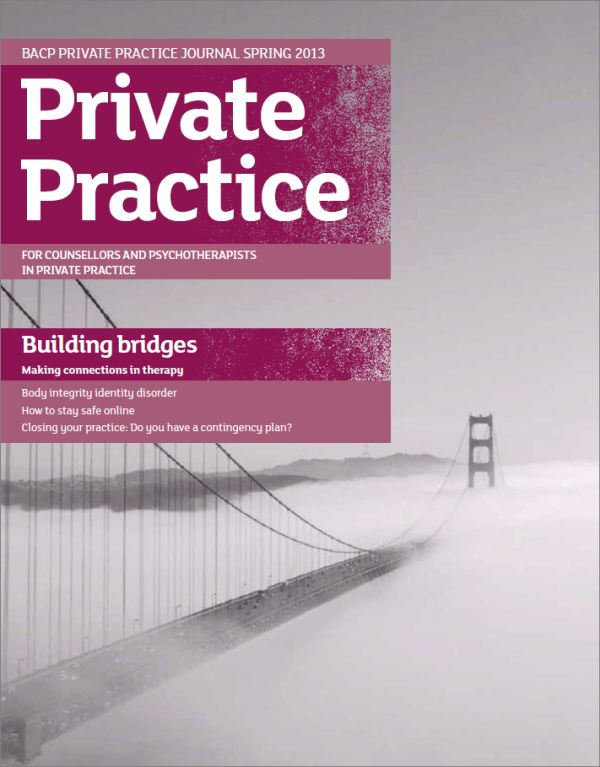In this issue
Features
My practice
Will I ever be good enough?
Claire Thomas is thrown into a panic when she sees her first client in her newly established private practice
Business matters
Demystifying social media
Sue Christy and John Bennett advise on how to take your first step into the world of social media
Ask an expert
Insurance for home workers
Steve Johnson answers two frequently asked questions about insurance for therapists who work from home
My inspiration
Building bridges
Trudi Dargan explores the metaphor of the bridge to explain the mystery of union that counselling offers
My practice
Is there a surgical solution to psychic pain?
Johanna Sartori asks whether there might be some clients for whom surgery offers the most benefit
My perspective
On believing the client
John Rowan argues that we cannot accept everything our clients tell us to be true
Toolbox
Closing the gap
James Rye shares solutions for helping increase the likelihood that clients will close the gap between making an initial enquiry and walking through the door to your consulting room
Practice matters
How to stay safe online
Martin Hogg offers five tips for setting boundaries online
My story
What is your plan B?
Elaine Davies asks what plans you’ve put in place should you have to close down your practice at short notice
Regulars
From the chair
Wendy Halsall: Adjusting to new challenges

Articles from this issue are not yet available online. Divisional members and subscribers can download the pdf from the Private Practice archive.
From the editor
I often find myself musing on the mystery and wonder of therapy. For clients, the experience can often feel one-sided. It is, after all, a relationship in which one person does most of the talking whilst the other listens. And yet a meeting takes place at a deeper, often unspoken level, which is mutual and reciprocal.
Trudi Dargan writes beautifully about this wordless exchange in her cover article, and uses the metaphor of the bridge to describe the two-sided, bi-directional nature of the therapeutic relationship. She also describes how as therapists we facilitate the creation of a network of bridges both between and within our clients and ourselves. For, when they step over our thresholds, our clients simultaneously invite us over theirs, and frequently enable us to learn as much about ourselves through the process of therapy as we help them to learn about themselves.
The theme of building bridges continues through a series of inter-related articles on how technology offers potential ways for service users and providers to communicate and engage. A recent report by the NHS Confederation’s Mental Health Network recommends the development of a national framework for ‘e-mental health’ and outlines the transformative role that technology might play in mental healthcare in the future.
Therapists in private practice are increasingly using interactive web platforms to engage with prospective and existing clients. Writing about the role social media can play, Sue Christy and John Bennett call Facebook ‘the reigning king of social media for private practitioners’ and provide seven steps to get you started if, like me, you don’t already have a Facebook account. Later in the issue, Martin Hogg offers essential guidance on protecting your privacy and that of your clients in his article ‘How to stay safe online’.
Having increased the flow of traffic to your website by engaging creatively with social media (if you’ve decided to take the plunge), the next challenge is to ease the process by which enquirers might then turn into regular clients. Technology can help here too, as James Rye explains. From virtual office assistants that field your telephone calls, to online electronic calendars for managing your bookings, new services and software can help increase the likelihood that clients will bridge the gap between making an initial enquiry and walking through your door for an appointment. And, in an increasingly competitive marketplace, it seems to me that if we want to build and maintain flourishing private practices, it is becoming less and less a viable option to resist what have fast become the predominant means of communication in all spheres of life.
As a bit of a Luddite and technophobe myself, however, I’m soothed by the less prosaic and more mysterious connections that Trudi Dargan writes about in her article about bridges. I am also drawn to Bion’s perspective, which she refers to in her review of Annie Reiner’s book Bion and Being: Passion and the creative mind: ‘Essentially for Bion, what remained “unknown” and “unknowable” was more important than what was known’. I also rather like and resonate with his description of therapy as a ‘jumble of bewilderment’! I’d love to hear what you think on these or any other issues that interest you. Please get in touch.
John Daniel
Editor
privatepractice.editorial@bacp.co.uk
Disclaimer and copyright
